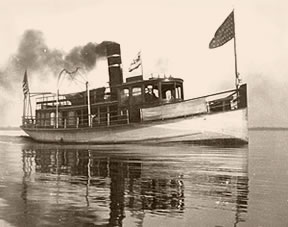
The yacht steamer Keystone on the St. Johns River. (Florida Photographic Collection Rc199992 — used by permission)
- Before European involvement in North America, the St. Johns River was called Welaka — or river of lakes, a name of Seminole-Creek origin.
- In the early 1500s, Spanish seamen called the river Rio de Corrientes — or river of currents.
- In 1562 — almost 50 years before the settlement in Jamestown — the French established Fort Caroline on a high bluff overlooking a river they called Riviere de Mai (River of May) because they arrived there on May 1.
- In 1565, Spanish soldiers marched north from St. Augustine, captured Fort Caroline and slaughtered the French. The Spanish renamed the river San Mateo to honor the saint whose feast followed the day they captured the river.
- Later, the river was renamed Rio de San Juan after a mission near its mouth named San Juan del Puerto. The English translation of the name Rio de San Juan — St. Johns River — lasted through English, Confederate and American possession of the river and remains today.
- Soon after England acquired Florida in 1763, King George III sent botanist John Bartram to explore Florida. His son, William Bartram, stayed in Florida and published his book Travels in 1791. It describes his exploration of the river as far south as Lake Harney.
- In the 1800s, steamboats made the St. Johns River a popular winter destination for northerners. By the 1860s, several steamers were making weekly round trips from Charleston and Savannah to Jacksonville and Palatka, and other settlements.
- Transportation has always been an important use of the St. Johns River. When William Bartram sailed down the river, he stopped briefly at an Indian village on the very spot where Palatka is located. Into the 1830s, the area was a trading post, until Fort Shannon was built there in the early 1840s to secure the strategic location during the Seminole Indian Wars. In the 1850s, Palatka became a port of entry into the interior of the state. Steamboats brought tourism and were vital to the city’s economy until the 1920s.

